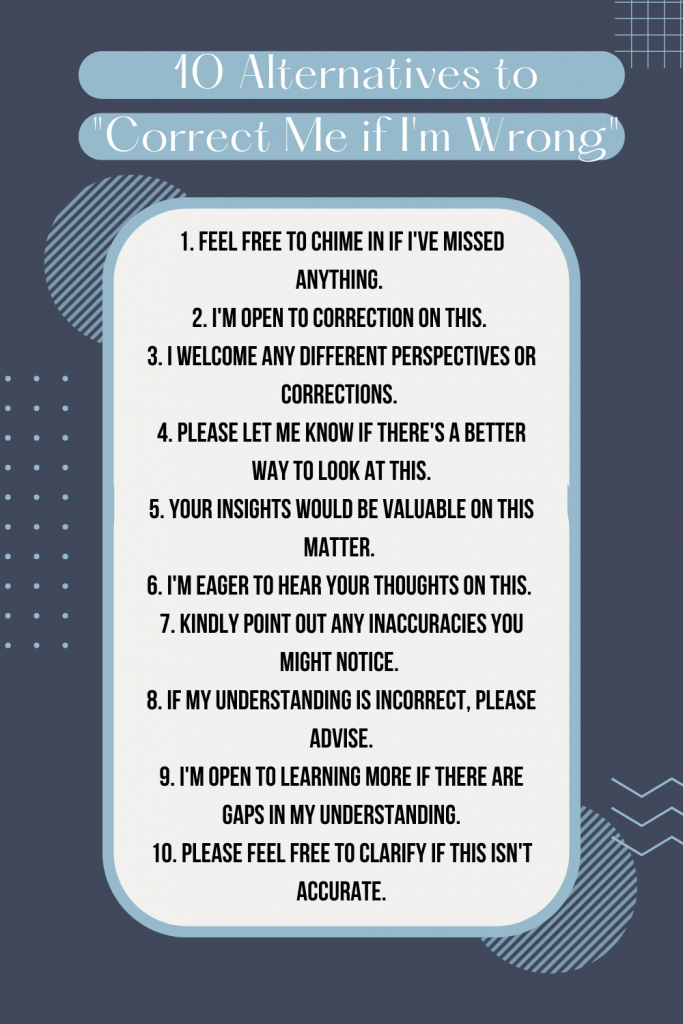It’s really important at work to walk that fine line between being sure of yourself and your expertise, but also staying open and willing to hear other people’s perspectives. If you act like you know everything, it can rub folks the wrong way. But if you’re constantly second-guessing yourself, that undermines your credibility too. It’s tricky to find the sweet spot!
But a simple line like Let me know if you have any other thoughts on this or Please correct me if I missed anything important leaves the door open for feedback while still demonstrating that you put some careful thought into what you wrote. It fosters more of a two-way dialogue instead of just blasting information out there.
Those attitudes—collaboration humility and a thirst for growth—are so valued in the workplace these days. So while it might feel awkward at first, inviting feedback through subtle phrasing in your professional emails is worth practicing. It will enhance your communication abilities and probably earn you some respect from colleagues along the way too.
This post “How to say ‘Correct Me if I’m Wrong’ in email,” is to provide you with practical tips and 10 alternatives to this classic phrase.
How to Say “Correct Me if I’m Wrong” in Email?
Place the phrase before a section where you’re seeking input, particularly if it involves details you’re unsure about. Here is a sample email:
Dear [Recipient’s Name],
I hope you’re doing well. I’m finalizing the agenda for our upcoming team meeting and wanted to confirm one of the discussion points.
Correct me if I’m wrong, but my understanding is that we agreed to prioritize the [specific project or topic] in this week’s meeting. If this isn’t the case or if there are additional items you believe should be included, please let me know.
Thank you for your guidance on this. I want to ensure the agenda accurately reflects our team’s current priorities.
Best regards,
[Your Name]
Alternatives to “Correct Me if I’m Wrong”
1. Feel free to chime in if I’ve missed anything.
Example: “In summary, the project will cover three main objectives. Feel free to chime in if I’ve missed anything crucial in this outline.”
Usage: that’s a good phrase when you’ve outlined a plan or recapped a meeting and want to make sure you didn’t overlook something. It’s a nice way to invite people to toss in their two cents or point out stuff you might’ve glossed over.
2. I’m open to correction on this.
Example: “I believe the new policy will take effect from next month, but I’m open to correction on this if anyone has more up-to-date information.”
Usage: When you aren’t 100 percent about something, maybe outside your expertise, this phrase is the clutch. Tells your coworkers or clients you did your best to get the facts straight but you’re open to being corrected. Shows that we want to foster a culture of openness and continuous learning where we all teach and learn from each other.
3. I welcome any different perspectives or corrections.
Example: “I’ve outlined the proposed marketing strategy as I see it, but I welcome any different perspectives or corrections from the team.”
Usage: This is a good way to show you’re open-minded when talking about complicated stuff where people might disagree. It makes you sound willing to hear other views instead of just pushing your own opinions. Saying that invites people to offer up different takes, which could give everyone a fuller picture.
4. Please let me know if there’s a better way to look at this.
Example: “I’ve suggested a linear approach to the project timeline. Please let me know if there’s a better way to look at this, given our constraints.”
Usage: Choosing “Please let me know if there’s a better way to look at this,” tells people you don’t think your way is the only way. You’re not going to be offended if you see holes or come at it from another angle. That says the goal is to find the right solution, not just pat yourself on the back. It says you care more about doing things the best way than being right.
5. Your insights would be valuable on this matter.
Example: “Given your experience with similar clients, your insights would be valuable on this matter, especially regarding customer engagement strategies.”
Usage: When you’re talking to someone who knows a lot about something, it’s good to ask them what they think. Saying that their insights would be really helpful tells them you respect their expertise. It also lets them know you want their input specifically.
6. I’m eager to hear your thoughts on this.
Example: “The draft of the budget plan is attached, and I’m eager to hear your thoughts on this, especially regarding the allocated resources for research and development.”
Usage: Another way to get people engaged is to say “I’m eager to hear your thoughts on this” and that shows you’re genuinely interested in their ideas and opinions. It’s a nice way of making them feel their thoughts matter in the conversation.
People like being asked what they think – it makes them feel valued. So go ahead and ask for their take! Tell them you want their insights and are eager to hear their thoughts. Those kinds of phrases open up the discussion.
7. Kindly point out any inaccuracies you might notice.
Example: “Attached is the report on our quarterly performance. Kindly point out any inaccuracies you might notice, so we can ensure it’s error-free.”
Usage: This is a polite way to ask someone to double-check your facts or data to make sure everything looks okay. You’d use it in situations where getting the details right really matters, like in a technical report or something. It shows you want to fix mistakes if there are any.
8. If my understanding is incorrect, please advise.
Example: “If my understanding is incorrect, please advise, especially regarding the implementation date of the new software system.”
Usage: It means that you’re open to being wrong and want to learn if your thinking is off. You might say that if you’re making a presentation on something complex you’re still figuring it out and it makes you seem willing to change your viewpoint.
9. I’m open to learning more if there are gaps in my understanding.
Example: “I’ve done a preliminary analysis of the market trends, but I’m open to learning more if there are gaps in my understanding of the current consumer preferences.”
Usage: This phrase says “I ain’t claiming to know everything here. If I’ve missed something or don’t fully get it,” I’m totally open to learning more. Just chime in if you think I need some help filling in any gaps.
10. Please feel free to clarify if this isn’t accurate.
Example: “My current understanding is that the budget has been increased to $50,000. Please feel free to clarify if this isn’t accurate.“
Usage: This phrase is very similar it says – If any part of what I’ve said seems off or inaccurate or whatever, speak up! I’m not always working with the latest info so feel free to straighten out anything I messed up and no harm no foul.

Conclusion
Those phrases are respectful ways to check if there’s anything you missed or got wrong. They invite people to speak up if your information isn’t accurate, rather than acting like you know it all. So they help you sound careful about facts instead of overconfident. Pretty handy for building trust when the specifics really count.
FAQs
1. Is it professional to use “Correct me if I’m wrong” in business emails?
Yes, it is considered professional. This phrase can convey humility and openness to collaboration, which are valuable in a business context. However, it’s essential to use it appropriately and in contexts where it genuinely fits.
2. Can “Correct me if I’m wrong” be perceived negatively?
In some cases, it might be perceived as a lack of confidence in your statements. To avoid this, balance its use with clear and confident communication elsewhere in your email.
3. When is the best time to use “Correct me if I’m wrong” in an email?
It’s best used when discussing topics where you are less certain, when presenting new ideas for feedback, or when summarizing discussions to ensure accuracy.
4. Should I use “Correct me if I’m wrong” in formal emails?
While it can be used in formal emails, consider your audience and the context. In very formal or critical communications, it might be better to use more formal phrases like “I look forward to your feedback” or “Please let me know if any adjustments are needed.”









